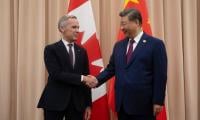‘Lumpy development’ and the Coase theorem
There is an old joke which makes an important point about efficiency and transaction costs. A non-smoker is trying to get a smoker to give up cigarettes. After failing to persuade him of the health benefits, he turns to finances.
“Every cigarette pack costs you 200 rupees. You’ve been smoking a pack a day for twenty years. If you hadn’t been smoking, you have saved enough to build a shopping plaza.”
The smoker stares back and asks, “You don’t smoke, do you?”
“No”, is the answer.
“Fine”, says the smoker. “Where’s your plaza?”
To understand why the non-smoker doesn’t have a plaza either, it helps to examine the work of Ronald Coase, winner of the Nobel Prize for Economics in 1991. While Coase achieved many things in a long and distinguished career, he is known best for a paper written in 1960, titled ‘The Problem of Social Cost’, and what is now generally referred to as the ‘Coase theorem’.
What the Coase theorem appears to say is that in a world where the transfer of rights is frictionless, the initial allocation of rights makes no difference to reaching an economically efficient outcome.
What the Coase theorem actually says is that since transfer costs are never actually zero, the initial allocation of rights makes a huge difference in determining whether the eventual outcome is economically efficient or not.
Let me first apologise to all economists out there whose discipline I am undoubtedly profaning. Now let me try and restate all that jargon in simpler words.
Imagine there is a factory – surrounded by people – which emits pollution. Imagine further that in order to stop polluting, the factory needs new technology worth $1 million. Finally, assume further that the net negative impact of the factory’s pollution on the lives of the people living next to the factory can be estimated at $10 million.
In this situation, clearly the optimal economic outcome is for the factory to invest in the new technology (and pass the increased cost on to the consumers). Coase’s point is that if transaction costs are zero, we will reach this optimal point irrespective of whether or not the factory has a right to pollute.
If the nearby residents have a right to stop the pollution, then the factory will have to install the new technology in order to continue operating. The additional cost will then be passed on to consumers.
If the residents can’t legally force the factory owner to stop polluting, then they will pay the factory owner $1 million to install the new technology (and thereby save themselves from $10 million worth of damage).
In real life, the situation is more complicated. If the nearby residents have to all chip in, the reality is that many people won’t actually be bothered enough and some will want a free ride. And if enough people can’t be bothered, the factory will continue polluting even though the economically rational result will be otherwise.
Net net, the point is this: since transaction costs are often high, rights should be initially allocated so as to make the economically optimal result more likely. In this particular case, it makes sense to give residents the right to stop the factory from polluting because it is easier for the factory owner to pay for the new technology.
Or in even simpler words, transaction costs matter.
Let’s come back now to the concept of ‘lumpy’ development. I first heard this phrase almost 20 years ago when I was adviser to an urban transportation project in Punjab. The point of the person using the phrase was that the government of Punjab wanted to spend its development money in ways that were ‘lumpy’, ie through high-profile, visible mega-projects.
My point today is that lumpy development not only makes political sense, it often also makes economic sense.
One paradigmatic example of lumpy development is the Lahore-Islamabad motorway. At the time it was conceived and approved, critics of the motorway cried themselves hoarse that it was a waste of money, that for a fraction of the amount involved, you could reap the same benefits by upgrading the GT Road and by investing in satellite roads. Another similar example is the ‘Jangla’ bus service in Lahore. As in the case of the Motorway, critics argue that it is expensive and that much the same benefits can be garnered from a host of small improvements in local transportation.
Lumpy development makes political sense because the public impact of one big intervention is exponentially more than the impact of 100 small interventions. That’s a simple fact well known to politicians which is why they all love ‘brick and mortar’ projects. Not only do they get their name on a plaque, but the public associates them forever with that one particular venture.
Arguing that lumpy development is economically efficient is a tougher argument but here’s my theory: the more actions needed to be taken for a particular project, the less likely that those actions will all be taken. Yes, in theory, Shahbaz Sharif could have invested the same amount of money in improving existing infrastructure as he did in the Metrobus service. But, in practice, managing an across-the-board equivalent improvement in Lahore’s transport infrastructure would have been horrendously difficult. To put it in abstract terms, the transaction costs of a 100 small coordinated projects often outweigh the additional financial cost of a larger project.
Let me use a different example. Pakistan has a number of extremely old Gencos whose equipment is not just old but positively decrepit. If that equipment was upgraded, those companies would generate electricity far more efficiently (ie cheaply). However, for the same amount of money, you could probably outfit most of Pakistan with energy efficient light bulbs. And for a given amount of money, the amount of electricity you would save by replacing old-fashioned incandescent bulbs with LEDs would probably be far more than by replacing old electricity generating equipment.
But here’s the thing. Trying to pull off a large-scale project (like replacing every single old bulb with a new LED bulb) requires a massive amount of national coordination. Not only would millions of bulbs need to be bought, they would have to be distributed as well. Thousands of people would need to be hired to get new bulbs to people and to make sure that they actually get utilised rather than thrown in a cupboard or sold back to a shop for a few rupees. Chances are that unless such a project was perfectly designed and perfectly executed, it wouldn’t do very well.
The object of this column isn’t to congratulate Messrs Nawaz and Shahbaz on the intelligent use of funds. The point is that public discussion of developmental alternatives has to take into account the efficiency with which a particular option can be executed. Transaction costs matter.
At the same time, large-scale, top-down development is very much not – repeat not – the only way forward. The truth is that development is a tricky business. Notwithstanding what the consultant hordes clinging to the coattails of the World Bank and the ADB may have to say, there normally isn’t one best way to develop. What works is trial and error. Sometimes large scale works better. And sometimes small is beautiful. In the immortal words of William Goldman, “Nobody knows anything.” The best that can be hoped for is an educated guess.
The writer is an advocate of the Supreme Court of Pakistan.
Twitter: @laalshah
-
 Taiwan, TSMC To Expand US Investment: A Strategic Move In Global AI Chip Race
Taiwan, TSMC To Expand US Investment: A Strategic Move In Global AI Chip Race -
 UN Chief Lashes Out At Countries Violating International Law; Warns 'new Geopolitics' Could Jeopardize World Order
UN Chief Lashes Out At Countries Violating International Law; Warns 'new Geopolitics' Could Jeopardize World Order -
 Carney Meets Xi In Beijing: Key Developments Revealed In The New Canada-China Trade Roadmap
Carney Meets Xi In Beijing: Key Developments Revealed In The New Canada-China Trade Roadmap -
 WhatsApp Adds New Status Privacy Check For Who Can See Your Updates
WhatsApp Adds New Status Privacy Check For Who Can See Your Updates -
 Prince Harry Takes On Dangerous Mission In 2026
Prince Harry Takes On Dangerous Mission In 2026 -
 Trump Accepts Nobel Peace Medal From Machado: What It Means For Venezuela Politics?
Trump Accepts Nobel Peace Medal From Machado: What It Means For Venezuela Politics? -
 Late-night Snacking Linked To Higher Risk Of Liver Disease
Late-night Snacking Linked To Higher Risk Of Liver Disease -
 John Mellencamp Gives Update On Daughter Teddi's Health Struggles: 'She's Suffering'
John Mellencamp Gives Update On Daughter Teddi's Health Struggles: 'She's Suffering' -
 ‘Disturbing Developments’ Start To Follow Prince William, Kate: ‘This Has The Makings Of A Crisis’
‘Disturbing Developments’ Start To Follow Prince William, Kate: ‘This Has The Makings Of A Crisis’ -
 Pamela Anderson Breaks Silence On Fallout With Ex-Tommy Lee: 'I Miss Him'
Pamela Anderson Breaks Silence On Fallout With Ex-Tommy Lee: 'I Miss Him' -
 Andrew Warned: ‘You’re Gonna Add Your Own Final Nail In The Coffin Of Reputation’
Andrew Warned: ‘You’re Gonna Add Your Own Final Nail In The Coffin Of Reputation’ -
 Ben Affleck Doesn't Want His Kids To Join Showbiz: Here's Why
Ben Affleck Doesn't Want His Kids To Join Showbiz: Here's Why -
 George R.R. Martin Calls 'House Of The Dragon' S3 'not My Story'
George R.R. Martin Calls 'House Of The Dragon' S3 'not My Story' -
 Jessi Ngatikaura Gets Real About ‘identity Crisis’ From Facial Surgery
Jessi Ngatikaura Gets Real About ‘identity Crisis’ From Facial Surgery -
 Timothy Busfield Faces Potential 15-year Prison Sentence If Convicted
Timothy Busfield Faces Potential 15-year Prison Sentence If Convicted -
 Kim Kardashian Gushes Over 'baby Girl' Chicago As She Turns 8
Kim Kardashian Gushes Over 'baby Girl' Chicago As She Turns 8



